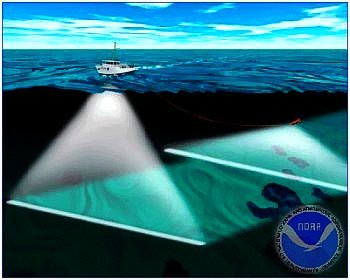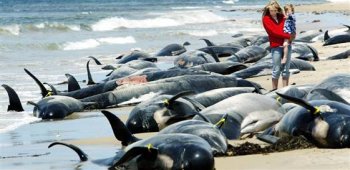Underwater Seismic Testing Linked To Whale Beachings
A controversial research project using sound waves, or sonar, to search for information about the asteroid that may have wiped out the dinosaurs 65 million years ago, began early on Friday, January 21, 2004 off Mexico's Yucatan Peninsula, amid protests from environmental activists.

Source: NOAA
The researchers are using underwater seismic pulses to learn more about the Chicxulub Crater (pronounced Sheek-shoo-LOOB), a depression measuring about 120 miles in diameter and centred just outside the port of Progreso, 190 miles west of Cancun.
Environmental activists say the technology used to create the underwater seismic pulses could harm whales and other marine life.
The same technique is routinely used by scientific research vessels around the world to study earthquake faults, tsunami dangers and climate change. It is used in Mexico by the state oil monopoly, Pemex, to search for new energy reserves, as it is by many oil exploration companies around the world, especially, according to the Acoustic Ecology Institute, in the North Sea, the Beaufort Sea (off Alaska's North Slope), the Gulf of Mexico and areas around Australia and South America.
Although the Mexican authorities have stated that the project is within 'acceptable limits', environmentalists say the sonic blasts damage the brain and ears of marine mammals and other species, disorienting them and causing them to beach themselves.

Whale Beachings in Tasmania, Australia and New Zealand on November 30th, 2004 - (Source: Independent Media TV
On board the Maurice Ewing, the research vessel owned by the U.S. National Science Foundation, is a team of marine seismologists from the University of Texas Institute of Geophysics, the Geophysics Institute at Mexico's Autonomous National University and Cambridge and London Universities.
The researchers will use compressed-air guns to send sound waves into the seabed. These will create a three-dimensional structural image of the crater and provide clues as to the asteroid's speed, angle at which it hit the Earth and its effects on the environment.
Gail Christeson, a University of Texas marine seismologist working on the project, said she had participated in at least four seismic cruises and "we have never seen any effect on marine life." She said she has seen dolphins swimming next to the boat that "don't seem to be affected at all as far as we can observe by air guns".
"And if there were large fish kills, you would see a flock of birds following the ship eating the dead fish. That's just not observed," she said.
But Rosario Sosa, president of the Yucatan-based civilian Association for the Rights of Animals and Their Habitat, said the sound waves "damage the brain, or damage the cochlea of the ear, and disorient the animals so that they beach themselves or crash into boats."
Sosa said that after the Maurice Ewing conducted research in the waters between the Baja California peninsula and mainland Mexico in October 2002, two beached whales were found in the area with evidence of damage to their ears.
She also said activists had come across dead dolphins and turtles in the gulf coast state of Campeche, where Pemex uses seismic pulses to explore for oil.
Increasing International Concern
This latest dispute comes at a time when there is increasing international concern over the potentially harmful effects on marine life of seismic testing.
On November 11, 2004, the 16 member states of the Agreement on the Conservation of Cetaceans in the Black Sea, Mediterranean Sea and contiguous Atlantic area (ACCOBAMS) approved a resolution calling for "extreme caution" in conducting activities that produce intense underwater noise.
This action came just two weeks after the European Parliament, seeking to protect marine mammals and other marine life, adopted a groundbreaking resolution calling for a moratorium on the use of high-intensity active naval sonars.
It also came days after the Spanish Ministry of Defence announced its intention to ACCOBAMS to prohibit all active sonar exercises off the coast of the Canary Islands, the site of many whale strandings coincident with military training exercises.
Recent Scientific Evidence
In December 2004, Science Magazine reported on the findings (.PDF file) of a research team at the Woods Hole Oceanographic Institution. The team, led by Michael J. Moore and Greg A. Early, have been inspecting bones from a collection of sperm whales.
They noticed that many of the bones contained lesions and pits, indicating the whales may have suffered mild, but chronic, decompression sickness over the course of their lives.
A swift ascent from deep water may be just as dangerous for whales as it is for humans, Science magazine reported. An acute form of the illness was also suspected in beaked whales, which were beached after a naval sonar exercise.
This has led researchers to speculate that sonar may distress whales into rising too quickly, resulting in potentially lethal cases of the bends.
Michael Moore said, "One of the quietest zones in the ocean is right up at the surface - they might be trying to get away from the noise."
Paul Jepson, of the Zoological Society of London, also studied the dead whales. He found they had bubbles in their tissues, which were consistent with severe decompression sickness. It is not certain how they got into this state, but it seems likely sonar was to blame.
"There is a very good correlation between naval sonar and the mass strandings of beaked whales, going back to the 1960s," said Dr Jepson. "The question is how is it making the animals strand?"
One theory suggests that the noxious boom of sonar causes the terrified animals to flee to the surface, triggering an acute form of the bends.
"We don't fully understand how they behave in response to sound," said Dr Jepson. "If we know the mechanism we can try to mitigate it and prevent it being potentially damaging to the animals."
Oil Exploration, Seismic Testing And Mass Whale Beachings - Recent Incidents
From November 28, 2004 to January 7, 2005, there have been recorded incidents of around 200 whale beachings on the coasts of the island of Tasmania, 240 km off the south-eastern coast of the Australian continent. This is an unprecedented number and has caused widespread concern.
On November 30, 2004, Australian Senator and Green Party Leader, Bob Brown, made a statement saying that ocean seismic tests to search for gas and oil should be stopped until the whale migration season had ended. His call followed the deaths of 19 long-finned pilot whales which beached at Tasmania's Maria Island the previous day. Just 24 hours earlier, 73 long-finned pilot whales and 25 bottlenose dolphins had been beached and had died.
Senator Brown said in both cases seismic tests, involving so-called sound bombing of ocean floors to test for oil and gas, were carried out in the days before the whales were stranded.
"There is growing evidence that such activities may impact on whales and dolphins, but research data is inconclusive," he said.
"However, the precautionary principle should apply and the tests, until shown to be safe, should stop - at least in whale migration seasons."
Induced Seismicity And Earthquakes
The environmental effects of underwater seismic pulse testing, whether for oceanographic research or for hyrdocarbon exploration, are becoming more evident, particularly in how it affects marine life.
There is, however, a growing body of highly accredited scientific evidence to suggest that induced seismicity could have profoundly more serious effects in terms of the impact on the global environment.
[ Read more ]
blog comments powered by Disqus